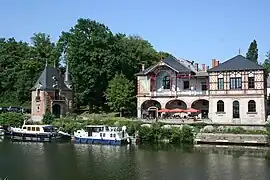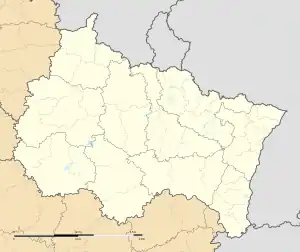Sarreguemines
Sarreguemines (French pronunciation: [saʁɡəmin]; German: Saargemünd [zaːɐ̯ɡəˈmʏnt] ⓘ, Lorraine Franconian: Saargemìnn) is a commune in the Moselle department of the Grand Est administrative region in north-eastern France.
Sarreguemines
Saargemünd | |
|---|---|
Subprefecture and commune | |
 View of the Saar River and the casino | |
 Flag  Coat of arms | |
Location of Sarreguemines | |
 Sarreguemines  Sarreguemines | |
| Coordinates: 49°07′N 7°04′E | |
| Country | France |
| Region | Grand Est |
| Department | Moselle |
| Arrondissement | Sarreguemines |
| Canton | Sarreguemines |
| Intercommunality | CA Sarreguemines Confluences |
| Government | |
| • Mayor (2020–2026) | Marc Zingraff[1] (LR) |
| Area 1 | 29.67 km2 (11.46 sq mi) |
| Population | 20,555 |
| • Density | 690/km2 (1,800/sq mi) |
| Time zone | UTC+01:00 (CET) |
| • Summer (DST) | UTC+02:00 (CEST) |
| INSEE/Postal code | 57631 /57200 |
| Elevation | 192–293 m (630–961 ft) |
| Website | sarreguemines.fr |
| 1 French Land Register data, which excludes lakes, ponds, glaciers > 1 km2 (0.386 sq mi or 247 acres) and river estuaries. | |
It is the seat of an arrondissement and a canton. At the 2013 France census, the town's population was 21,572. The inhabitants of the commune are known as Sarregueminois and Sarregueminoises.
Geography
Sarreguemines, whose name is a French spelling of the name in local Lorraine-German dialect "Saargemin", meaning "confluence into the Saar", is located at the confluence of the Blies and the Saar, 79 kilometres (49 mi) east of Metz, 107 kilometres (66 mi) northwest of Strasbourg by rail, and at the junction of the lines to Trier and Sarrebourg.[3] Sarreguemines station has rail connections to Strasbourg, Saarbrücken and Metz. Traditionally Sarreguemines was the head of river navigation on the Saar, its importance being a depot where boats were unloaded.
Population
|
| ||||||||||||||||||||||||||||||||||||||||||||||||||||||||||||||||||||||||||||||||||||||||||||||||||||||
| Source: EHESS[4] and INSEE (1968-2017)[5] | |||||||||||||||||||||||||||||||||||||||||||||||||||||||||||||||||||||||||||||||||||||||||||||||||||||||
Administration
Sarreguemines was, from 1985 to 2015, the seat of two cantons:
- Sarreguemines, consisting of the Sarreguemines commune only.
- Sarreguemines-Campagne, comprising 21 nearby communes.
Both cantons, minus the communes of Grundviller, Guebenhouse, Loupershouse and Woustviller that were added to the canton of Sarralbe, were merged into one canton of Sarreguemines on January 1, 2015.
History
Sarreguemines, originally a Roman settlement, obtained civic rights early in the 13th century. In 1297 it was ceded by the count of Saarbrücken to the Duke of Lorraine, and passed with Lorraine in 1766 to France.[3]
It was transferred to Germany in 1871, with the Treaty of Frankfurt following the Franco-Prussian War. From 1871 to 1918 it formed part of the German imperial province of Alsace-Lorraine and manufactured plush velvet, leather, faience and porcelain, and was a centre for making papier-mâché boxes, mostly used for snuffboxes.[3] It was returned to France after World War I.
On December 21–23, 1944, the 44th Infantry Division (United States) threw back three attempts by the Germans to cross the Blies River. An aggressive defense of the Sarreguemines area was continued throughout February and most of March 1945.
Notable people
Sarreguemines was the birthplace of :
- Jean-Pierre Bachasson, comte de Montalivet (1766–1823), Peer of France and a French statesman
- Auguste Hilarion Touret (1797 – 1858) - French philhellene officer and a participant in the War of Independence of Greece
- Maximilian von Jaunez (1873–1947), industrialist and politician
- Hans Traut (1895-1974), general
- Marianne Oswald (1901-1985), singer
- Karl Ullrich (1910-1996), Knight's Cross holder
- Eugen-Ludwig Zweigart (1914-1944), pilot
- Céleste Lett (born 1951), politician
- Michel Roth (born 1959), chef
- Eric Hassli (born 1981), French footballer
- Lucien Schmitthäusler (1935–2020), writer and educator
- Matthieu Sprick (born 1981), French cyclist
- Erza Muqoli (born 2005), French singer
See also
References
- "Répertoire national des élus: les maires". data.gouv.fr, Plateforme ouverte des données publiques françaises (in French). 2 December 2020.
- "Populations légales 2020". The National Institute of Statistics and Economic Studies. 29 December 2022.
- One or more of the preceding sentences incorporates text from a publication now in the public domain: Chisholm, Hugh, ed. (1911). "Saargemünd". Encyclopædia Britannica. Vol. 23 (11th ed.). Cambridge University Press. p. 954.
- Des villages de Cassini aux communes d'aujourd'hui: Commune data sheet Sarreguemines, EHESS (in French).
- "Population en historique depuis 1968" (in French). INSEE. 12 September 2020.
External links
- Official website
- http://realtravel.com/sarreguemines-lorraine-travel-guide-d1772892-1.html
- http://www.travelpost.com/EU/France/Lorraine/Saargemund/6224215
- http://www.voyage-scolaire.com/france/sarregms/index.html
- http://www.sarreguemines-museum.com
- Médiathèque d'Agglomération Sarreguemines Confluences